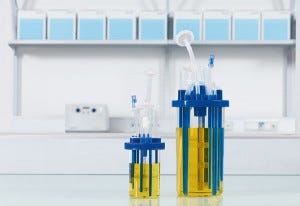Parallel Cultivation of Microorganisms - Using Rigid-Wall Single-Use Bioreactors
January 8, 2015
Sponsored by Eppendorf
with Dr. Sebastian Kleebank
In recent years, single-use bioreactor solutions have been successfully established for animal and human cell culture processes. Such technology is under investigation for microbial applications. Sebastian Kleebank is development and application laboratory manager for the Eppendorf line of bioprocess products. His cell culture and microbial laboratory performs parallel cultivations for prototype testing, user training, and software development.
Kleebank’s Presentation
“The BioBLU 1f bioreactor has a gas-inlet filter for sterile gas supply. It has a fully featured head plate and innovative cooling baffles for high mass transfer rates and cooling capacity. Each vessel has a noninvasive dissolved oxygen (DO) sensor port. The DO sensor does not directly contact culture medium because of a silicone membrane at the bottom. This bioreactor has three Rushton-type impellers, and some versions have two; both use a magnetic drive assembly for stirring. For exhaust condensation, it uses a Peltier-based liquid-free exhaust condenser.
“We performed a fourfold parallel cultivation of the Escherichia coli strain K12. A preculture was incubated with an Innova 42R incubator shaker using LB medium at 37 °C. That was transferred to four BioBLU 1f vessels in a DASGIP Bioblock parallel cultivation system. Here, we used a mineral medium also at 37 °C.
“After inoculation, the DO concentration dropped from 100% to ~20% parallel in all four bioreactors because of bacterial growth and increased metabolic activity. To prevent DO concentration from dropping <0%, we used a DO cascade: increasing stirrer speed and then oxygen content in the inlet gas stream. We began with 40-g/L glucose concentration; after glucose was depleted, the DO concentration sharply increased (a “glucose starvation peak”). Our software can recognize that peak and automatically initiated feeding in all bioreactors. We started at 14.7 mL/h using a 500-g/L glucose solution. Over the course of the experiment, the feeding rate was reduced to 5 mL/h.
“After the batch the four bioreactors avereaged oxygen transfer rates (OTRs) of ≤200 mmol/L/h. After feeding started, they reached 150–200 mmol/L/h. After we decreased the feeding, those values dropped to 100 mmol/L/h. For comparison, we applied exactly the same process to autoclavable glass bioreactors, and the OTR graph was comparable.
“The four BioBLU 1f bioreactors achieved cell wet weights of 160 g/L (averaged). The high reproducibility we obtained proves that they can be used for precise process control. The autoclavable bioreactorsreached 140 g/L.
“The BioBLU 1f bioreactor is suitable for high–cell-density cultivations. Because of the cooling baffles, we saw heat transfer rates of >50 W/L. So we can effectively get rid of the biological heat that forms during high–cell-density cultivation.
“This bioreactor also reduces turnaround times. It comes presterilized, so you don’t need to clean it. After a culture, you don’t need to inactivate, disassemble, clean, reassemble, and sterilize it. You can start your next process within the same day. This increases process throughput from one to two runs per week or from two to three.
“All wetted parts of this bioreactor are USP class VI-certified.”


Questions and Answers
Q: Is the oxygen sensor polarographic or fluorescent?
A: It is polarographic.
Q: What type of sparger is used?
A: The sparger is simply a dip tube.
Q: Can you describe DO and pH measurement? Do probes need to be aseptically installed?
A: The polarographic DO sensor can stay connected to our control system, so you don’t need to wait for polarization. When the bioreactor is ready, you simply insert the DO sensor into the noninvasive port. For pH, we used normal glass sensors that you can separately autoclave and then mount into the bioreactor under laminar flow using a Pg 13.5 port of the head plate.
Q: What is the biggest size?
A: The biggest microbial version is this 1-L vessel with a working volume range of 250–1,250 mL. For cell-culture applications, we have bigger versions with ≤40-L working volume.
Q: Do we need the heating block?
A: For the BioBLU 1f you would need a DASGIP Bioblock that offers integrated heating and cooling of four bioreactors. Additionally, four cooling baffles are installed in each bioreactor, and they can be connected to a cooling water distribution unit to effectively cool down the bioreactor.
Q: Can you maintain the posted kLa values in your larger vessel sizes?
A: The kLa values we determined were in a BioBLU 1f unit for microbial applications. Our larger cell culture vessels don’t need kLa values that high.
Q: Do the units come gamma sterilized?
A: We are using beta irradiation. The bioreactor comes presterilized and double-bagged.
More Online
The full presentation of this “Ask the Expert” webcast — with data — can be found on the BioProcess International website at http://bit.ly/1infJTY.
You May Also Like





